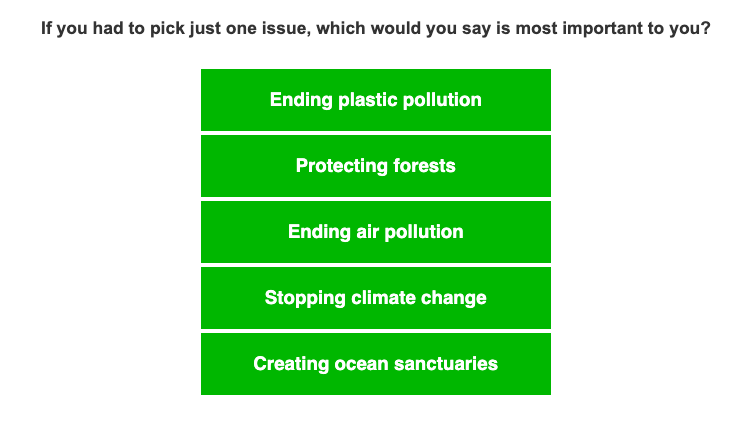Email is a key line of communication to your supporters as a nonprofit organization.
Unfortunately, your carefully crafted messages mean little if people don’t notice and open them. Chances are that your subscriber’s inbox is chock-full of emails, all from organizations and businesses vying for their attention.
That’s why one simple subject line can make all the difference. Studies have shown that nearly 47 percent of people choose whether or not to open an email based solely on its subject line, and an even larger 69 percent of people report emails as spam based on the subject line alone.
Those figures may seem intimidating, but they do make sense. A subject line is a signpost that tells your supporters whether or not your email is interesting, and therefore whether your organization is worth their attention and donations. That’s why you should spend some time thinking about the signals you want to send.
To help you get the most out of your nonprofit subject lines, here are seven simple and actionable strategies for upgrading them into intriguing, clickable snippets that grab your subscribers’ attention and engage them with your cause.
How to Write Effective Nonprofit Subject Lines
1. Keep It Short
Given the incredibly short space of time, you have to make an impression, one of the most crucial things you can do is keep your subject lines short and sweet.
When a subject line aims to get readers to click through, you don’t need an essay to get your point across. What you do need, though, is something that can be read at a glance.
According to Hubspot, the ideal length of a subject line is 50 characters or less. Any more than that, your words will get cut off, and your open rates will too. In fact, all of the subject lines you’ll see in this article are under that limit, including this example from Water.org:

This subject line is a masterclass in brevity. In just three words, it lets you know exactly what their organization is trying to achieve and why, while still leaving room for curiosity and intrigue. This way, you know what you’re getting into when you click it, but you still want to read more.
Another thing that makes this example so eye-catching is that it’s a little unconventional. The brand could have easily said, “Safe water means opportunity” or something similar, but using the equals sign makes their email stand apart from the crowd.
If you’re trying to cut down the length of your subject lines, try similarly using a sign or symbol. You could also substitute words for emojis if that’s your style.
2. Ask a Question
Another way to create intrigue in a subject line is to ask your subscribers a question. The more thought-provoking it is, the more it will make them pause for a second, and the more they’ll want to open the email.
Your question could be a rhetorical one, making the recipient consider what the answer could be and curious to find out more, or it could be more like this example from Greenpeace:

Greenpeace first caught my attention with this email by personalizing it with my name, and then asked a simple but provocative question: what’s important to me? This question isn’t necessarily something that I don’t know and want to find the answer to, but instead, it’s something that I want to answer myself.
Now, it’s also a pretty broad question, but I always love an opportunity to talk about the things that matter to me. So I clicked on the email, and saw this:

It turns out that they were asking me which causes matter most to me so that they can let me know about future campaigns I might care about.
This is a perfect way to engage new supporters with their organization, not only by encouraging their participation but by refining their email list and making their emails as relevant as possible. This way, they are much more likely to have loyal subscribers who read about and support important causes.
3. Make It Actionable
If your organization is struggling with converting a growing email list into concrete support and donations, you may need to work on how actionable your subject lines are.
People often can feel overwhelmed in the face of issues that need their support, especially when suffering or injustice is on a large scale. Perhaps they can’t donate, or already have made donations but don’t feel like they’ve done enough to help.
That’s where you come in, with specific, actionable, and feasible ways to help. And how do you let your subscribers know that you’ve come up with these ways? In the subject line. I particularly like how Planned Parenthood does it:

At the time of writing this article, Black Lives Matter activism is happening all over the world right. People are encountering things all the time that make them angry and want to help the cause.
But unfortunately, the sheer amount of information that’s out there, often contradictory, can make people feel confused and powerless instead.
Planned Parenthood shows in this subject line that they understand these feelings and want to give their subscribers the direction and power to help.
They make it urgent and relevant to the cause and address the recipient directly, so you know that you can open the email and make a real difference in the world.
4. Create Urgency
Making messages feel urgent is a tried-and-tested method in marketing to evoke a feeling of scarcity and compel quick decisions. What makes it all the more important in nonprofit marketing is that urgency is so often an integral part of the causes that need support.
You may well know this about your cause, but you can use your subject lines to make sure your subscribers know it. Giving them a deadline for action puts an end to the umm-ing and ahh-ing about donating.
This subject line from the Alzheimer’s Association is a great template to follow:

This is a simple, straightforward message of urgency to their subscribers, but it does its job well.
When this arrived in my inbox, I had seen their previous emails about matching donations. Still, I did what so many people do, and thought “interesting, I’ll take a look later” and proceeded to forget about it altogether. This one, however, was different.
It made me stop and take notice and realize that I couldn’t just procrastinate on donating if I wanted to have my contribution matched and make double the difference.
To give this kind of subject line even more impact, be as specific as possible with your deadline. Telling your supporters that they have eight hours or until midnight to take action can make them think realistically about what they will do in that time, and how much easier it will be to act right then and there.
5. Spark Emotions
It’s unfortunate that some of your subscribers just aren’t invested in your organization as you’d like them to be.
For those people, no amount of “donate now”s or “last chance to help”s is going to spur them into action. What is needed is something to help them form a real connection with your cause.
Inspiring some emotion in your subscribers without being exploitative can be tricky to walk, but I think the International Rescue Committee does it well:

In this short but powerful subject line, they manage to get across a whole host of important things. They tell you exactly who you’ll be helping, and how crucial it would be to help them.
After all, the difference in word choice between “helping” refugees and being a “lifeline” to them means the difference between a single donation and a long-lasting commitment to supporting your organization.
By highlighting your organization’s human element in your subject lines, you will make your emails stand out from the crowd of those asking for help and donations for nameless and vague causes.
6. Use a Holiday
People often feel more generous and charitable around the holiday season, which means they’re often more willing to pay their attention to good causes.
So, to make sure that their eyes land on your emails, try spending time creating some seasonally-specific emails with some seasonally-specific subject lines.
Of course, there are the most obvious winter holidays to target, but you don’t have to stop there. There are a lot of holidays and national days that, if you spend a little time searching, can be very related to the causes you’re promoting.
Take World Bee Day, for example, which the World Wildlife Fund (WWF) picked out for one of their campaigns:

I presume that many others hadn’t heard of World Bee Day before I saw this subject line. But now I have, and I’m intrigued to learn how it relates to WWF’s cause and how they’re commemorating it.
The promise of a free gift, like WWF, is offering in this email, can be an enticement to open an email by itself, but combined with this holiday, it packs a double-punch. Holidays can act as motivators to taking action. After all, if there’s only World Bee Day a year, why not leap and support their campaign?
7. Provide a Follow-Up
Finally, convincing someone to make one donation or support one campaign, while an achievement in itself, doesn’t always convert into a more long-term commitment.
That’s why you should always send follow-ups to your supporters as a way to say thank you. Like everyone, they want to feel appreciated, and to have their support acknowledged by your organization.
The Make-A-Wish Foundation does this perfectly in one of their recent follow-up emails. This is the subject line:

From this subject line, you can immediately tell that your actions have been impactful—that the money and support that you have donated to Make-A-Wish has had a directly positive effect on the life of a young girl. If that doesn’t give you a warm, fuzzy feeling inside, then I don’t know what might.
Invoking feelings like that by showing the fruits of your organization’s labor makes the recipient feel like part of your team, which gets you closer to creating a real relationship with them. If you show that you care about your supporters, your supporters will care right back.
Conclusion
Ultimately, your subject lines should act as little reminders that small actions can lead to big differences in people’s lives.
Sometimes, getting people to show their caring sides with real, concrete giving can be hard, but the first step is always getting them to open your email. Once they do that, then you know you can persuade them to listen.



